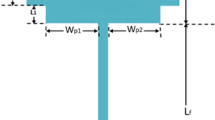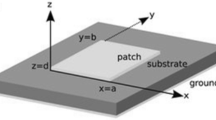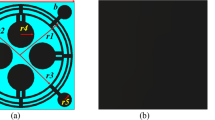Abstract
In communication systems microstrip patch antennas must operate in circular polarization. To fulfill this requirement, a new type of antenna is studied microstrip patch antennas printed on a ferrite substrate, which can naturally generate circular polarization with only one feed point. Few theoretical methods allow the study of rectangular microstrip patch antennas on ferrite substrate. An original method based on a finite difference time domain approach is introduced in this paper. After a description of this numerical method, a validation is made, then some characteristics of such antennas are given.
Résumé
L’introduction des antennes microrubans dans les systèmes de communication nécessite des éléments capables de fonctionner en polarisation circulaire. Afin de pouvoir générer une telle polarisation, de nouveaux types d’antennes sont étudiés. En particulier, les antennes plaques sur un substrat ferrite polarisé per mettent de générer naturellement de la polarisation circulaire. Peu de méthodes permettent une étude d’antennes de forme rectangulaire de ce type. Aussi une technique originale d’analyse par une méthode aux différences finies est proposée dans cet article. Aprés une présentation de la méthode, une validation a été effectuée. De même, quelques résultats sur les caractéristiques de telles antennes sont données.
Similar content being viewed by others
References
James (J. R.), Hall (P. S.). Handbook of microstrip antennas. Peter Peregrinus LTD (1989).
Bahl (I. J.), Bhartia (P.). Microstrip antennas. Artech House (1980).
James (J. R.), Hall (P. S.), Wood (C.). Microstrip antenna theory and design. IEE Electromagnetic Waves Series 12, Peter Peregrinus LTD (1981).
Deschamps (G. A.). Microstrip microwave antennas. 3rd USAF, Symposium on Antennas (1953).
Das (N.), Chasserjee (T. T.). Quaterwave microstrip antenna on a ferrimagnetic substrate.Electronics Letters (juin 1981),17, no 13, pp. 441–442.
Das (N.), Mishra (R. K.), Pattnaik (S. S.). Elliptical microstrip antenna on ferrite substrate.Electronics Letters (oct. 1990),26, no 22, pp. 1905–1907.
Pozar (D.). Radiation and scattering characteristics of microstrip antennas on normally biased ferrite substrate.IEEE Trans. AP (sept. 1992),40, no 8, pp. 1084–1092.
Taflove (A.), Brodwin (M. E.). Numerical solution of stadystate electromagnetic scattering problems using the time domain dependent Maxwell’s equation.IEEE Trans. MTT (août 1975),19, no 8, pp. 623–630.
Holland (R.). Threde: a three field emp coupling and scattering code.IEEE Trans. NS (dec. 1977),24, no 6, pp. 2416–2422.
Merewether (M. E.). Transient current induced on a metallic body of revolution by an electromagnetic pulse.IEEE Trans. EMC (mai 1971),13, pp. 44–47.
Kunz (K. S.). A three-dimensional finite difference solution of the external response of an aircraft to a complex transient EM environment: part I : the method and it is implantation.IEEE Trans. EMC (mai 1978),20, no 2, pp. 328–333.
Reineix (A.), Jecko (B.). Analysis of microstrip patch antennas on a dielectric substrate using the finite difference time domain method.IEEE Trans. AP (nov. 1989),37, no 11, pp. 1361–1369.
Wu (Ch.), Wu (K. L.), Bi (Z. Q.), Litva (J.). Accurate characterization of planar printed antennas using finite difference time domain method.IEEE Trans. AP (mai 1992),40, no 5, pp. 526- 534.
Yee (K. S.). Numerical solution of initial boundary value problems involving Maxwell’s equations in isotropic media.IEEE Trans. AP (mai 1966),14, pp. 302–307.
Lax-Button. Microwave ferrites and ferrimagnetics. Mac Graw Hill.
Sooho (R. F.). Theory and application of ferrites. Practice Hall International EMC (1960).
Reineix (A.), Monedère (Th.), Jecko (F.). Ferrite analysis using the FDTD method.Microwave and Optical technology letters,15, no 13, pp. 685–686.
Author information
Authors and Affiliations
Rights and permissions
About this article
Cite this article
Reineix, A., Melon, C., MonÉdiÈre, T. et al. The FDTD method applied to the study of mjcrostrip patch antennas with a biased ferrite substrate. Ann. Télécommun. 49, 137–142 (1994). https://doi.org/10.1007/BF02999476
Received:
Accepted:
Issue Date:
DOI: https://doi.org/10.1007/BF02999476




